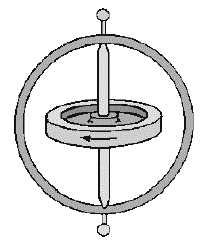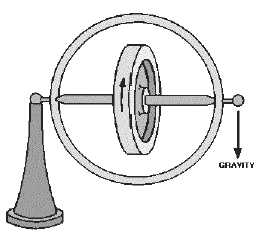3-3
Figure 3-2.—A gyroscope top.
PRECESSION
Now, if you stop the gyro top and turn its axis horizontal, and then start it spinning again, balancing
one end on a pivot, (fig. 3-3), it won't fall. The top's axis will stay horizontal, resisting the tendency of
gravity to change its direction Although the gyro will RESIST the force that gravity applies to it, the gyro
will still RESPOND to that force. The gyro responds by moving its axis at a RIGHT ANGLE to the
APPLIED FORCE.
Figure 3-3.—Gyro top with axis horizontal.
The axis will tilt in a direction 90º away from the applied force. This is called PRECESSION.
Figure 3-4 is another view of the same gyroscope. Its far end is still balanced on the pivot. Gravity is
pulling down on the gyro. If the gyro rotor is turning in the direction shown by the arrow, the near end of
the frame (axis) will move to the left. If the rotor were turning in the opposite direction, the frame would
move to the right. Note that in each of these examples the direction of movement was displaced from the
applied force (gravity) by 90º. The axis stays horizontal, but the gyroscope responds to the force of
gravity by rotating around the pivot.




